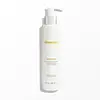What's inside
What's inside
 Key Ingredients
Key Ingredients

No key ingredients
 Benefits
Benefits

No benefits
 Concerns
Concerns

 Ingredients Side-by-side
Ingredients Side-by-side

Water
Skin ConditioningCaprylic/Capric Triglyceride
MaskingGlycerin
HumectantPropanediol
SolventCocamidopropyl Hydroxysultaine
CleansingSodium Acrylate/Sodium Acryloyldimethyl Taurate Copolymer
Emulsion StabilisingCetyl Alcohol
EmollientAloe Barbadensis Leaf Juice
Skin ConditioningYucca Schidigera Root Extract
Skin ConditioningHelianthus Annuus Seed Oil
EmollientNiacinamide
SmoothingAllantoin
Skin ConditioningTocopheryl Acetate
AntioxidantP-Anisic Acid
MaskingCeramide Ng
Skin ConditioningDisodium Cocoyl Glutamate
CleansingPolyisobutene
Sucrose Stearate
EmollientAcrylates/C10-30 Alkyl Acrylate Crosspolymer
Emulsion StabilisingSodium Cocoyl Glutamate
CleansingXanthan Gum
EmulsifyingDisodium EDTA
Sodium Hydroxide
BufferingCaprylyl/Capryl Glucoside
CleansingCaprylyl Glycol
EmollientXylitol
HumectantCaprylic Acid
CleansingLinalyl Acetate
MaskingLinalool
Perfuming4-Terpineol
MaskingOcimene
PerfumingSodium Chloride
MaskingTetrasodium EDTA
Lauramidopropyl Dimethylamine
Sorbitan Oleate
EmulsifyingCitric Acid
BufferingWater, Caprylic/Capric Triglyceride, Glycerin, Propanediol, Cocamidopropyl Hydroxysultaine, Sodium Acrylate/Sodium Acryloyldimethyl Taurate Copolymer, Cetyl Alcohol, Aloe Barbadensis Leaf Juice, Yucca Schidigera Root Extract, Helianthus Annuus Seed Oil, Niacinamide, Allantoin, Tocopheryl Acetate, P-Anisic Acid, Ceramide Ng, Disodium Cocoyl Glutamate, Polyisobutene, Sucrose Stearate, Acrylates/C10-30 Alkyl Acrylate Crosspolymer, Sodium Cocoyl Glutamate, Xanthan Gum, Disodium EDTA, Sodium Hydroxide, Caprylyl/Capryl Glucoside, Caprylyl Glycol, Xylitol, Caprylic Acid, Linalyl Acetate, Linalool, 4-Terpineol, Ocimene, Sodium Chloride, Tetrasodium EDTA, Lauramidopropyl Dimethylamine, Sorbitan Oleate, Citric Acid
Ingredients Explained
These ingredients are found in both products.
Ingredients higher up in an ingredient list are typically present in a larger amount.
Citric Acid is an alpha hydroxy acid (AHA) naturally found in citrus fruits like oranges, lemons, and limes.
Like other AHAs, citric acid can exfoliate skin by breaking down the bonds that hold dead skin cells together. This helps reveal smoother and brighter skin underneath.
However, this exfoliating effect only happens at high concentrations (20%) which can be hard to find in cosmetic products.
Due to this, citric acid is usually included in small amounts as a pH adjuster. This helps keep products slightly more acidic and compatible with skin's natural pH.
In skincare formulas, citric acid can:
While it can provide some skin benefits, research shows lactic acid and glycolic acid are generally more effective and less irritating exfoliants.
Most citric acid used in skincare today is made by fermenting sugars (usually from molasses). This synthetic version is identical to the natural citrus form but easier to stabilize and use in formulations.
Read more about some other popular AHA's here:
Learn more about Citric AcidWater. It's the most common cosmetic ingredient of all. You'll usually see it at the top of ingredient lists, meaning that it makes up the largest part of the product.
So why is it so popular? Water most often acts as a solvent - this means that it helps dissolve other ingredients into the formulation.
You'll also recognize water as that liquid we all need to stay alive. If you see this, drink a glass of water. Stay hydrated!
Learn more about Water